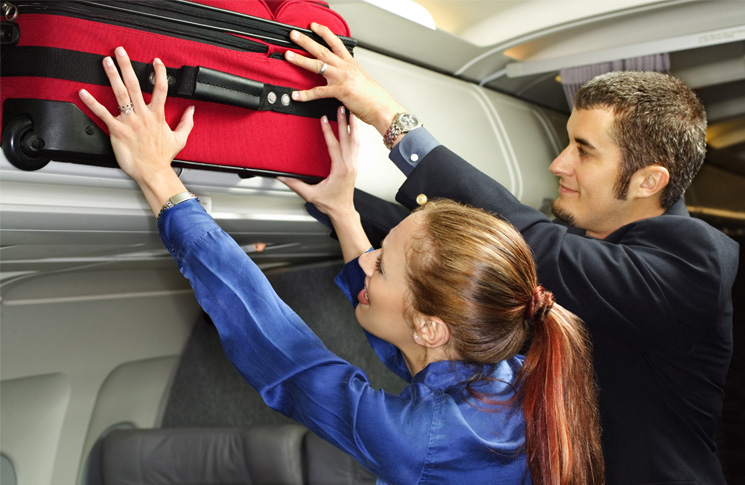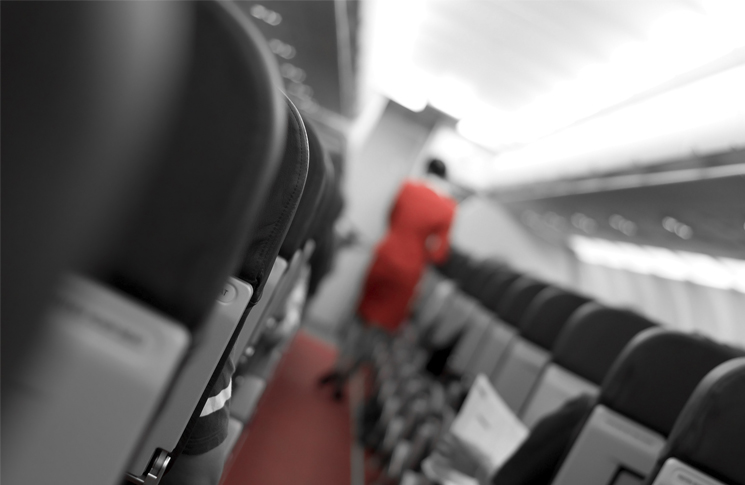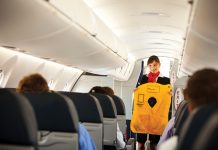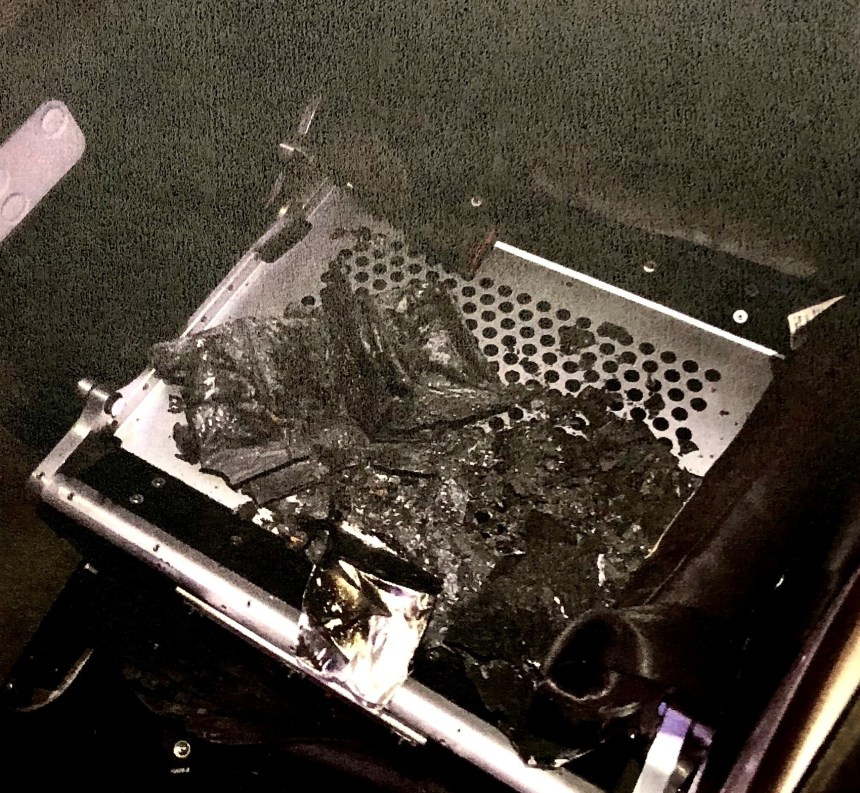Much has been written condemning passengers who reach for their luggage in an aircraft evacuation. Why they do it, and what can be done to prevent it, are harder questions
The slippery dip might have been fun as a child, but if you’re in an emergency on an aircraft, using the evacuation slide/raft correctly is no laughing matter. It would seem common sense that taking your carry-on luggage down the slide/raft would be a definite ‘no-no’.
But British Airways flight 2276 on 8 September, demonstrated that human behaviour in emergencies can be far from rational. The Boeing 777 caught fire early in its take-off run. The Guardian journalist Jacob Steinberg, also a passenger on the flight, describes the harrowing situation:
Before I drifted off, people were reading, chatting and starting to watch the in-flight entertainment and, as usual, I had not paid much attention to the safety demonstrations.
You get into a comfort zone when you fly a lot and think that something as terrifying as what was to come could never happen to you. I think differently now.
There was a shout to evacuate the plane. Some people were trying to run, others further ahead were moving slowly, perhaps not realising how serious the situation was. There were even some passengers who tried to get their luggage out of the overhead lockers.
I’ve subsequently seen some criticism of them on Twitter but if you weren’t there, how do you know how you would have reacted? People do odd things when they panic.
The images of passengers wandering away from the burning 777 dragging and wheeling their carry-on baggage show people do odd things when they panic. But surely we all know carrying luggage down an emergency exit quite simply compromises passengers and the crew’s safety?
Not an unusual occurrence
BA 2276 was beginning a scheduled flight from Las Vegas to Gatwick when a fire broke out in the port engine of the Boeing 777-200 while it was on the runway. The aircraft had 157 passengers as well as 13 crew on board.
But BA 2276 isn’t the only plane that’s implemented emergency measures this year. In March 2015 alone there were three flights that resulted in emergency evacuations and evidence that passengers are not leaving their carry-on items behind:
- US Airways 445 in Denver—the pilot was alerted to possible smoke in the cabin while taxiing to the gate. The 158 passengers and crew deplaned via the slides.
- Turkish Airlines 726 in Kathmandu—dense fog in Nepal caused the plane to overshoot the runway, forcing staff and 224 passengers to evacuate the aircraft.
- Delta 1086 at New York LaGuardia—while landing at the airport in a snowstorm the plane skidded off the runway and into an earthen berm that separates the airport from Flushing Bay. Three people were hospitalised, but no one was killed and all 127 passengers were successfully evacuated.
Power, risk, perception and control
There’s no doubt that risking your life—as well as other passengers’ lives—for the sake of a bag seems unbelievable. But perhaps it’s not as simple as that.
It’s easy to vilify these passengers on social media networks and in the media, but CASA human factors advisor, Reuben Delamore, says there can be several reasons why people behave in this way during an aviation emergency.
‘We’re a bit like sheep in a lot of ways. Habits and familiarity may prompt some of the behaviour and are probably factors,’ he says. ‘Then there are very individual elements such as the need to gain control of “something” in a situation that may be seen as otherwise out of their control. Social theories such as the “commons” dilemma, or versions of “it’s ok if I take this, I’m not going to cause a problem” can create a snowball effect through observational learning. As an example, if the cabin crew allows one person take their bag off the plane during an emergency then they (the crew) are stuffed because other people will then try to do it as well.’
Delamore says for some people who are very used to being in control of their normal lives and situations, being on an aircraft is uncomfortable because suddenly they have no control.
‘From a risk perspective, we are very much in the moment, and if we don’t have an accurate perception of what the risk is we will tend to start thinking about what other risks or impact may exist,’ he says.
‘For instance, as a passenger, if one of your problems was that you had a meeting to be at and this incident is incredibly inconvenient you start to think “what can I do to salvage this? Well I need to take my bag because that’s got the stuff I need in it.” For that passenger, it’s like a positive solution for other problems that aren’t necessarily associated to the evacuation.’
Delamore also suggests that the baggage may have a level of importance that balances life elements against risk of surviving the evacuation. Should a passenger need medication to survive, then that bag will be firmly grasped in their hands.
‘In the case of BA 2276 the smoke wasn’t visible for some of the passengers within the cabin. This means that the perception of personal risk may have been less for some individuals when compared to those who were able to see, smell or even feel the fire and smoke. The moment you start getting the smell of danger or death that perception of risk changes, potentially transitioning from a decision-making process into a fight/flight type mode.’
This helps to explain why the baggage issue is not always a problem. In some evacuations, the gravity of risk to survival presents a very directed motivation.
Delamore also says that passengers don’t necessarily understand the context of the risk and why taking their bag is an issue. Currently passengers in most demonstrations are not informed why baggage should not be taken with them.
‘From an operational perspective that provides the crew with two problems: one is damage to the slide raft, which increases workload and delays in managing the evacuation, and the other is if bags start coming up, where do you put them? Particularly in a single aisle aircraft when you’ve lost one of the exits.’
It’s a no-win situation for cabin crew. While they could demand those who turn up with luggage at the emergency exit leave it behind, there’s also the dilemma that passengers need to exit within 90 seconds through just 50 per cent of the exits. If just a few of those passengers turn up with their luggage, there’s nowhere to put it—leaving it behind near the top of the slide raft, or throwing it out to the ground could create another hazard.

Safety strategies
Steinberg makes a significant point while earlier describing BA 2276: I had not paid much attention to the safety demonstrations.
How many of us do in fact pay attention to the safety videos or the cabin crew? For those who work in aviation watching the demonstration is a matter of professional courtesy, or should be, but for frequent flyers its repetitive nature is undeniable.
Airlines know this, and some are experimenting with different formats for the video safety demonstration. But CASA cabin safety inspector, Julie Parkinson, says even though passenger safety information has been enhanced through these humorous deliveries (such as Air New Zealand’s Men in Black safety video), it hasn’t necessarily increased passenger safety.
‘Yes, a funny safety video will get a passenger’s attention, but the actual retention of information doesn’t actually improve,’ Parkinson says.
After the BA 2276 incident, the British Civil Aviation Authority issued a safety instruction (SN–2015/0060) to British registered airlines to urgently review safety instructions and stop passengers taking their hand luggage with them in an emergency evacuation. The SN noted that most operators warn passengers in their safety briefing but ‘some passengers appear not to assimilate, or not to heed such [safety] information and remain unaware of its significance to their and their fellow passengers’, overall safety.’
In response to the incident Australia’s own aviation regulator the Civil Aviation Safety Authority (CASA) issued a warning to industry through the Flight Safety website noting a concerning trend where airline passengers are continuing to value their luggage over their own personal safety and that of their fellow travellers. CASA—along with other Regulatory bodies such as the European Aviation Safety Agency (EASA) and the International Civil Aviation Organization (ICAO)—are currently in the process of reviewing their guidance material to incorporate information pertaining to passengers leaving their baggage behind in an evacuation.
However, is this sufficient, or should there be specific penalties that apply in such cases when passengers don’t comply? Parkinson says there would be difficulty of enforcing monetary fines. ‘Because it is such an extreme situation, how will we really penalise people for reacting to and behaving in such a way?
ICAO’s Cabin Crew Safety Training Manual specifies in the event of an ‘anticipated’ emergency landing that crew brief passengers to leave carry-on behind. Going a step further, ICAO guidelines recommend that cabin crew be trained to prevent passengers from taking carry-on along when they evacuate via emergency slides.1
Other preventative measures could include automatic locking of overhead cabin bins and enforcing carry-on restrictions for size or weight. Leaving bags behind is a shared responsibility: for passengers to comply and for airlines and regulators to consistently inform why it is important for safety. As BA 2276, and several other evacuations every year demonstrate, one sentence in a briefing telling people what to do is not enough.
Don’t tempt me: things you can do to resist grabbing your bag
- Have travel insurance to cover the cost of replacing your luggage and contents.
- Keep your passport, wallet, ticket, phone and any essential medication on your person.
- If you fly with a laptop or tablet computer, back up its files so that your whole life’s work is not in one memory chip.






Comments are closed.